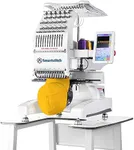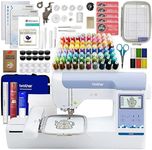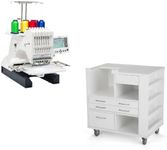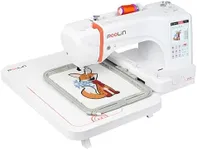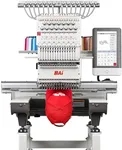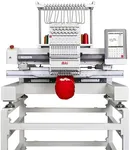Buying Guide for the Best Commercial Embroidery Machines
Choosing the right commercial embroidery machine can be a game-changer for your business. Whether you're starting a new venture or upgrading your current equipment, it's important to understand the key specifications that will impact your productivity, quality, and overall satisfaction. By focusing on these specs, you can ensure that you select a machine that meets your specific needs and helps you achieve your business goals.Number of NeedlesThe number of needles on an embroidery machine determines how many colors you can use in a single design without needing to change threads manually. This is important because it affects the efficiency and complexity of your embroidery work. Machines typically range from single-needle to multi-needle (up to 15 or more). For simple designs or small businesses, a machine with fewer needles (4-6) might suffice. However, for more complex designs and higher production volumes, a machine with more needles (8-15) will be more efficient and versatile.
Embroidery AreaThe embroidery area is the maximum size of the design that the machine can stitch in one go. This is crucial because it limits the size of the projects you can undertake. Smaller machines might have an embroidery area of 4x4 inches, suitable for small logos and patches. Larger machines can offer areas of 12x18 inches or more, allowing for bigger and more intricate designs. Consider the typical size of your projects when choosing the embroidery area; larger areas provide more flexibility but may come at a higher cost.
Stitch SpeedStitch speed, measured in stitches per minute (SPM), indicates how fast the machine can operate. This is important for productivity, especially in a commercial setting where time is money. Entry-level machines might offer speeds of 400-600 SPM, which is adequate for small-scale operations. High-end commercial machines can reach speeds of 1000-1500 SPM or more, significantly increasing output. Choose a machine with a stitch speed that matches your production needs; higher speeds are beneficial for large orders and tight deadlines.
Built-in Designs and FontsBuilt-in designs and fonts refer to the pre-programmed patterns and text styles available on the machine. This feature is important for convenience and creativity, allowing you to quickly start projects without needing external software. Machines with a larger library of built-in designs and fonts can save time and provide inspiration. If you frequently create custom designs, ensure the machine also supports importing designs via USB or other means. The right balance depends on your workflow; more built-in options can streamline operations, while import capabilities offer greater flexibility.
Connectivity and Software CompatibilityConnectivity and software compatibility determine how easily you can transfer designs to the machine and what software you can use for creating and editing designs. This is important for integrating the machine into your existing workflow and ensuring you can use your preferred design tools. Machines may offer USB ports, Wi-Fi, or direct computer connections. Compatibility with popular embroidery software can enhance your design capabilities. Choose a machine that supports the connectivity options and software you are comfortable with, ensuring a smooth and efficient design process.
Hoop Sizes and TypesHoop sizes and types refer to the frames that hold the fabric in place during embroidery. This is important because different projects require different hoop sizes and types for optimal results. Machines typically come with multiple hoop options, ranging from small (4x4 inches) to large (12x18 inches) and specialty hoops for caps or sleeves. Consider the variety of projects you plan to undertake and ensure the machine includes or supports the necessary hoop sizes and types. Having a range of hoops allows for greater versatility and precision in your work.
Ease of Use and Learning CurveEase of use and the learning curve are critical factors, especially if you or your team are new to commercial embroidery machines. This includes the user interface, controls, and available tutorials or customer support. A machine that is intuitive and easy to learn can save time and reduce frustration. Look for features like touchscreen displays, clear instructions, and responsive customer support. If you're a beginner, prioritize machines known for their user-friendly design. For experienced users, advanced features might be more important, but ease of use should still be considered to ensure efficient operation.

